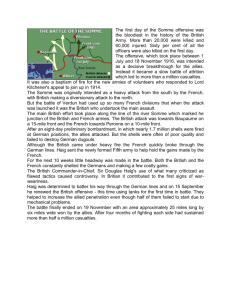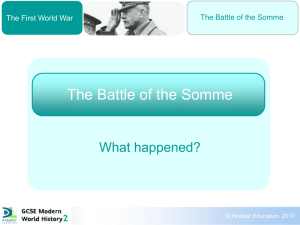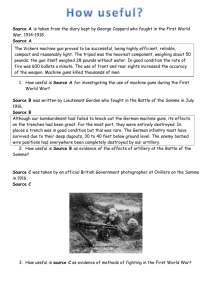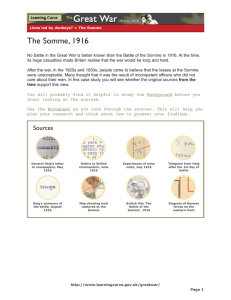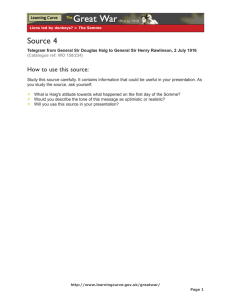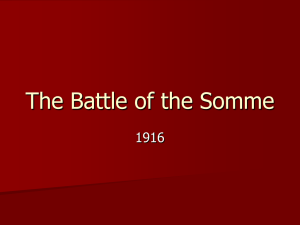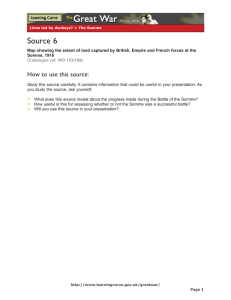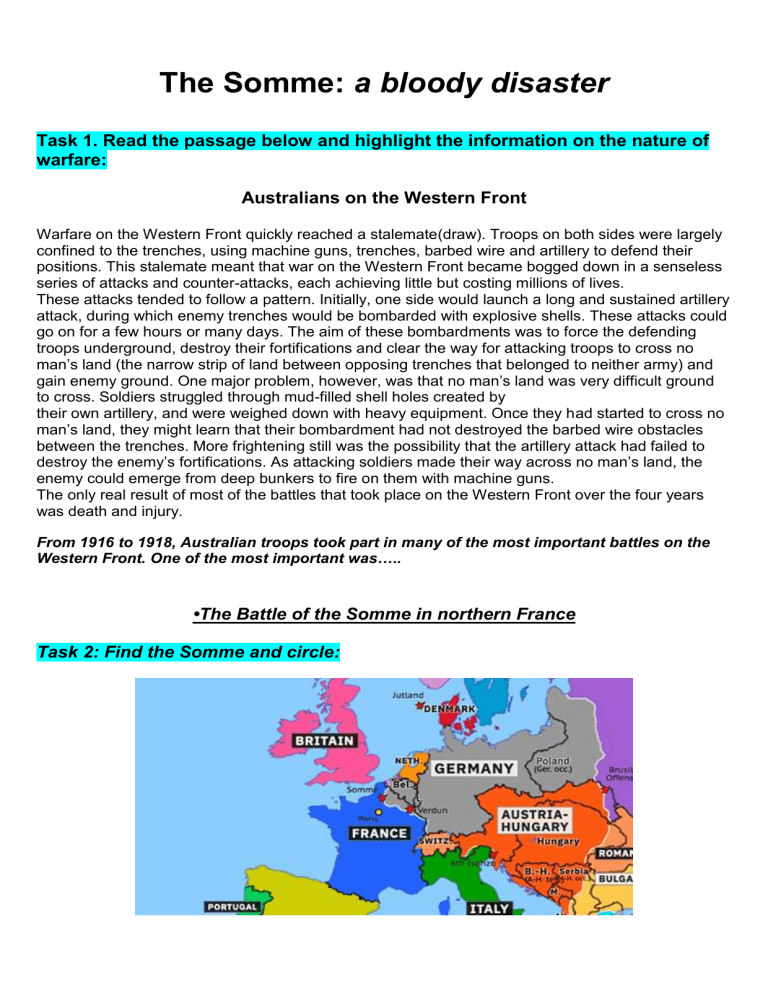
The Somme: a bloody disaster Task 1. Read the passage below and highlight the information on the nature of warfare: Australians on the Western Front Warfare on the Western Front quickly reached a stalemate(draw). Troops on both sides were largely confined to the trenches, using machine guns, trenches, barbed wire and artillery to defend their positions. This stalemate meant that war on the Western Front became bogged down in a senseless series of attacks and counter-attacks, each achieving little but costing millions of lives. These attacks tended to follow a pattern. Initially, one side would launch a long and sustained artillery attack, during which enemy trenches would be bombarded with explosive shells. These attacks could go on for a few hours or many days. The aim of these bombardments was to force the defending troops underground, destroy their fortifications and clear the way for attacking troops to cross no man’s land (the narrow strip of land between opposing trenches that belonged to neither army) and gain enemy ground. One major problem, however, was that no man’s land was very difficult ground to cross. Soldiers struggled through mud-filled shell holes created by their own artillery, and were weighed down with heavy equipment. Once they had started to cross no man’s land, they might learn that their bombardment had not destroyed the barbed wire obstacles between the trenches. More frightening still was the possibility that the artillery attack had failed to destroy the enemy’s fortifications. As attacking soldiers made their way across no man’s land, the enemy could emerge from deep bunkers to fire on them with machine guns. The only real result of most of the battles that took place on the Western Front over the four years was death and injury. From 1916 to 1918, Australian troops took part in many of the most important battles on the Western Front. One of the most important was….. •The Battle of the Somme in northern France Task 2: Find the Somme and circle: Go to https://www.ducksters.com/history/world_war_i/battle_of_the_somme.php TASK 3: Use the site to complete the passage below by deleting the incorrect word from the ones in red:The Battle of the Somme occurred in 1916/1917 was one of the smallest/largest battles that occurred during World War I. The battle was fought between the Allies (British and French Empires) on one side and Germany/Russia. For many British soldiers it was their first battle. They were part of a volunteer army called Haig’s/Kitchener's Army, which was recruited in 1915 by Lord Kitchener (see the famous poster to the right). Groups within the British army were called Pal's battalions because the volunteers were guaranteed to be placed in battalions with their enemies/friends and neighbours – which encouraged greater volunteering. Many brothers joined together and went to war in the same group. The Somme Offensive (attack) was planned by the British Commander-in-Chief Sir Douglas Haig/ Kitchener's. He wanted to break the stalemate/victory that had developed due to the building and reinforcing of trenches over two years. His plans were changed when the Germans went on the offensive and attacked the French/Austrians at the Battle of Verdun. The French demanded that the British bring forward the attack at the Somme in hopes that German forces would be diverted from Verdun/Somme to the Verdun/Somme. Before the attack began, the British bombarded the German trenches with over 1,600,000 artillery shells (the bombs shot from cannons). Haig thought this would destroy the German barbed wire/plastic defences and kill/injure most of their troops. However, the Germans took shelter form the bombardment and knew it was a warning that they were going to be attacked. Little real damage was done to the German fortifications and many of the British shells were successes/duds and never even exploded. After eight days of bombardment, on July 1, 1916/1918, Haig began the attack. Thousands of British soldiers got out of their trenches and began to advance on the German lines – many were told to run/walk in lines because there wouldn’t be any Germans alive. Haig was also worried about the level of training of the soldiers as they were new to the army. The Germans easily gunned/tackled them down. It was the worst/best day in the history of British warfare. They suffered around 60,000 casualties including 20,000/100,000 dead on that first day of battle. Because many men from the same town were grouped together in the British Pal's battalions, when a battalion was wiped out, often this meant that all the men from a given city/town in Britain were killed. Despite the heavy casualties, the Allies continued to attack/retreat. They didn't stop attacking until November 18. Over the 4½ months the Allies/Germans suffered around 623,000 casualties. The Germans suffered about 500,000 casualties because their generals ordered that every time the British advanced, German forces would have to attack and take the ground back. With over 1,000,000 total casualties on each side, the Battle of the Somme/Gallipoli was one of the easiest/bloodiest battles in human history. The stalemate was successfully/not broken. TASK 4: Examine the sources and complete the analysis questions below These photos are of German and British troops manning machine guns on the Western Front in 1916. 1. Are the photos above primary or secondary sources? _____________________________________________________________________________ 2. Describe the content that is shown in these photos? _____________________________________________________________________________ _____________________________________________________________________________ 3. Using your own knowledge on the nature of warfare in WW1, what additional information can we gain from these photos? _____________________________________________________________________________ ______________________________________________________________________________ 4. Whose perspective are they from? _____________________________________________________________________________ 5. Does the perspective make the sources more useful or less useful? Why? _____________________________________________________________________________ _____________________________________________________________________________ 6. How reliable are the photos? Give reason(s) _____________________________________________________________________________ _____________________________________________________________________________ 7. Why are these sources useful to someone studying the Western Front? ______________________________________________________________________________ ______________________________________________________________________________ TASK 5 -Extention: Source 6.40 “We are lousy [infested with lice], stinking, ragged, unshaven, sleepless. Even when we’re back a bit we can’t sleep for our own guns. I have one puttee [fabric strip wound around the lower leg for protection], a dead man’s helmet, another dead man’s gas protector, a dead man’s bayonet. My tunic is rotten with other men’s blood and partly splattered with a comrade’s brains. It is horrible but why you people at home not know.” A letter from John Alexander Raws to his family. A soldier who spent only four weeks on the Western Front before he was killed in shelling in 1916. What makes Source 6.40 a reliable source of evidence for a historian trying to understand conditions in the trenches of the Western Front? What limitations are there for a historian researching conditions across the entire Western Front? ______________________________________________________________________________ ______________________________________________________________________________ ______________________________________________________________________________ ______________________________________________________________________________
